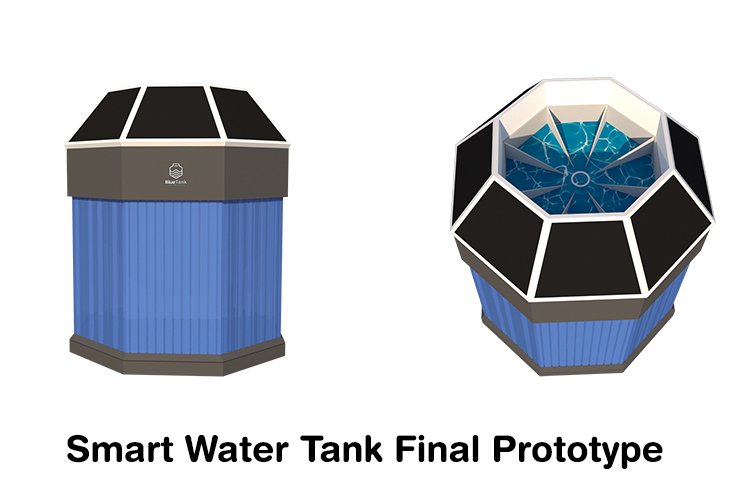
Smart Watertank Design Thinking and UI Design
Context Brief
The challenges and solutions related to household water tanks. It highlights various pain points, such as construction and installation issues, maintenance concerns, water quality problems, limited capacity, operational costs, regulatory compliance, contamination risks, aesthetic and odour issues, energy consumption, and lack of monitoring and automation.
The proposes solutions to address these pain points, including space-saving tank designs, automated cleaning and disinfection systems, integrated water filtration and purification, modular and expandable tank capacities, energy-efficient pumps and motors, streamlined regulatory frameworks, advanced water treatment technologies, water circulation and aeration systems, solar-powered pumping systems, and smart home integration with tank monitoring and control.
The ideation section presents a concept for a “Water Jar with Water Dispenser,” including sketches and a final prototype.
As a UI designer, you can leverage this information to understand the user’s pain points, desired features, and potential solutions when designing a user interface or application related to household water tank management. The design thinking research and ideation can inform the user experience, functionality, and visual elements of the UI, ensuring it addresses the identified pain points and incorporates the proposed solutions effectively.
Problem Statement: Addressing Challenges in Household Water Tank Management
Household water tanks face various issues, including installation difficulties, maintenance concerns, water quality problems, capacity limitations, high operational costs, regulatory compliance challenges, contamination risks, aesthetic and odor issues, energy consumption, and lack of monitoring and automation. These problems can lead to water insecurity, increased expenses, and potential health risks for families.
Crafted Solution
A smart water tank system can address the challenges by incorporating features such as space-saving designs, automated cleaning and disinfection, integrated water filtration and purification, modular and expandable capacity, energy-efficient pumps and motors, streamlined regulatory compliance, advanced water treatment technologies, water circulation and aeration, solar-powered pumping, and smart home integration with tank monitoring and control.

Project Goal
- Improve Water Security: Develop a reliable and efficient smart water tank system to ensure a consistent emergency water supply and promote water self-sufficiency.
- Enhance Water Quality: Implement advanced water treatment technologies and monitoring systems to maintain high water quality standards and prevent contamination.
- Increase Capacity and Flexibility: Design modular and expandable tank solutions to accommodate varying household water storage needs and enable rainwater harvesting integration.
- Optimize Energy Efficiency: Incorporate solar-powered or hybrid pumping systems, energy-efficient tank designs, and insulation to reduce energy consumption and operational costs.
- Streamline Maintenance: Implement automated cleaning, disinfection, and proactive maintenance strategies to minimize maintenance efforts and costs.
- Ensure Regulatory Compliance: Align the smart water tank system with local regulations, permits, and building codes, and provide assistance for compliance requirements.
- Promote Sustainability: Encourage water conservation and reduce reliance on municipal water sources through rainwater harvesting and optimized water usage.
- Enhance User Experience: Develop a user-friendly interface and smart home integration for remote monitoring, control, and efficient water management.
Team
Only one member means single person and that was me.
Duration
2 months
My role
As a designer, my role was to find the user’s problem and then design better service and experience for the users.
Tools Utilised
Figma
Adobe Photoshop
Adobe Illustrator
Pain Points

Ideation



Water Tank Logo Design

Conclusion
Challenges: The document highlights various challenges associated with household water tanks, including installation difficulties, maintenance issues, water quality concerns, capacity limitations, high operational costs, regulatory compliance challenges, contamination risks, aesthetic and odour problems, energy consumption, and lack of monitoring and automation.
Learnings: Through design thinking and ideation, the document explores solutions to address these challenges, such as space-saving designs, automated cleaning and disinfection systems, integrated water filtration and purification, modular and expandable capacity, energy-efficient pumps and motors, streamlined regulatory compliance, advanced water treatment technologies, water circulation and aeration, solar-powered pumping, and smart home integration with tank monitoring and control.
Outcomes: The proposed solutions aim to improve water security, enhance water quality, increase capacity and flexibility, optimize energy efficiency, streamline maintenance, ensure regulatory compliance, promote sustainability, and enhance user experience through a user-friendly interface and smart home integration for efficient water management.
